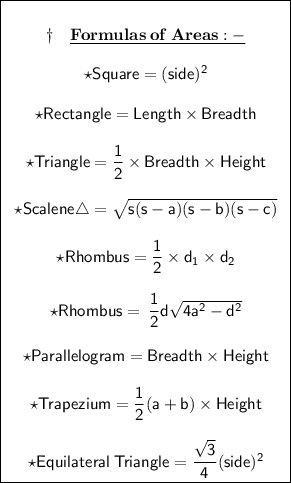Explanation:

Given that,
- ABCD is a square of side x cm
- EFGH is a square of side y cm
Further given that,
- Sum of all sides = 52 cm
It means
- Perimeter of square ABCD + Perimeter of square EFGH is 52 cm
We know,
![\purple{\rm :\longmapsto\:\boxed{\tt{ Perimeter_([square]) \: = \: 4 * side \: }}}](https://img.qammunity.org/2022/formulas/mathematics/high-school/t72zrojh35ssamebkio7ivi02kmshjiijq.png)
So, using this, we have



Now, Further given that,
If square EFGH is cutting out from square ABCD, the area of remaining part is 91 square cm.
It means
![\rm :\longmapsto\:Area_([ABCD]) - Area_([EFGH]) = 91](https://img.qammunity.org/2022/formulas/mathematics/high-school/ci52mkj1j8nxflse6zxbm6pytprwfg9106.png)
We know,
![\purple{\rm :\longmapsto\:\boxed{\tt{ Area_([square]) = 4 * side}}}](https://img.qammunity.org/2022/formulas/mathematics/high-school/dzeu9ff9yqwpifk8gqo1ez84p52hgmkzya.png)
So, using this, we get

can be further rewritten as using algebraic Identity,




On adding equation (1) and (2), we get



On substituting the value of x in equation (1), we have



So,
![\rm\implies \:\boxed{Side_([square \: EFGH]) = y \: = 3 \: cm}](https://img.qammunity.org/2022/formulas/mathematics/high-school/haqqrtp8fnl72c0bygpn869czyzyy73eob.png)
and
![\rm\implies \:\boxed{Side_([square \: ABCD]) = x \: = 10 \: cm}](https://img.qammunity.org/2022/formulas/mathematics/high-school/kerpuu96dhb08cwi1o1rqe0i100oh0vfez.png)
Also,
![\rm :\longmapsto\:\boxed{Area_([square \: ABCD]) = {10}^(2) = 100 \: {cm}^(2) }](https://img.qammunity.org/2022/formulas/mathematics/high-school/d2xs9idajvafx5lycfx8gsmifjetrbmym5.png)
![\rm :\longmapsto\:\boxed{Area_([squareEFGH] )\: = {3}^(2) = 9 \: {cm}^(2) }](https://img.qammunity.org/2022/formulas/mathematics/high-school/gqr4h05mmika9ddjztj8qnt5e39qq5e4ok.png)
▬▬▬▬▬▬▬▬▬▬▬▬▬▬▬▬▬▬▬▬▬▬▬▬
